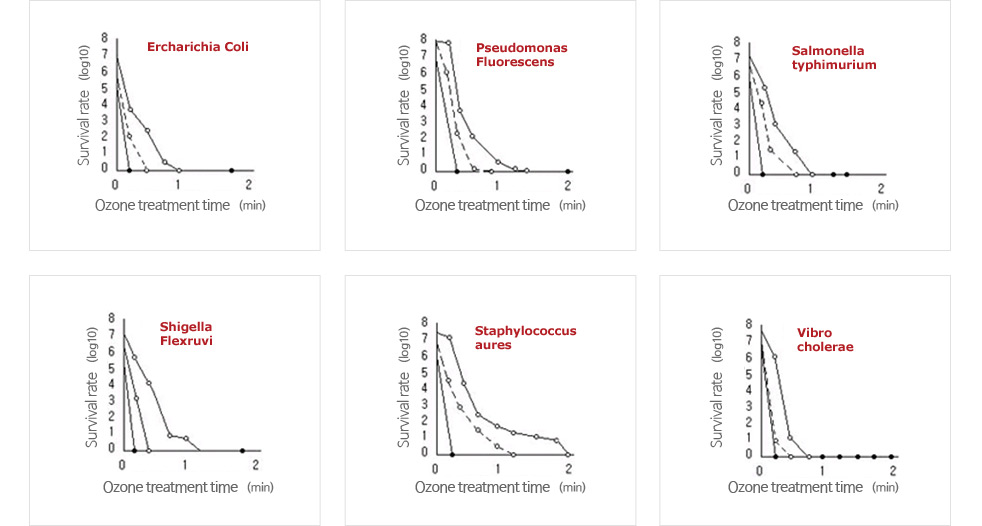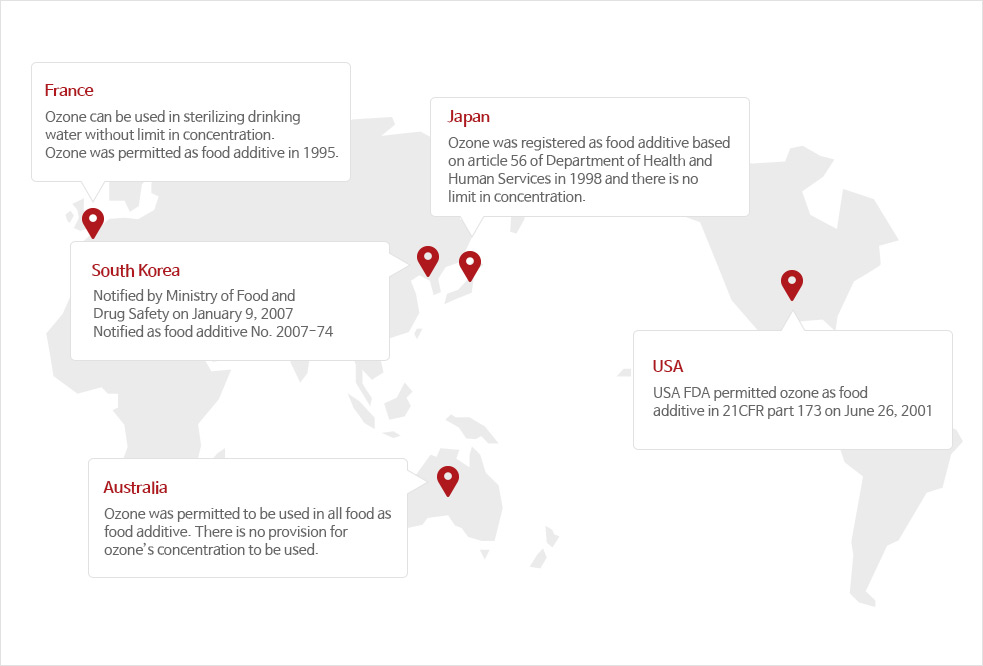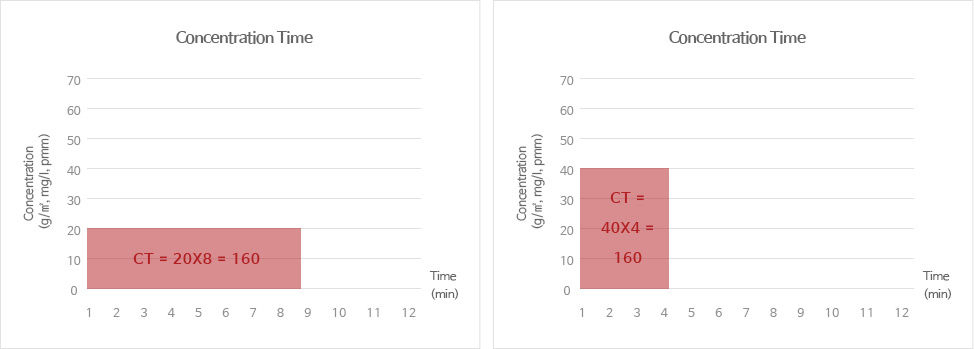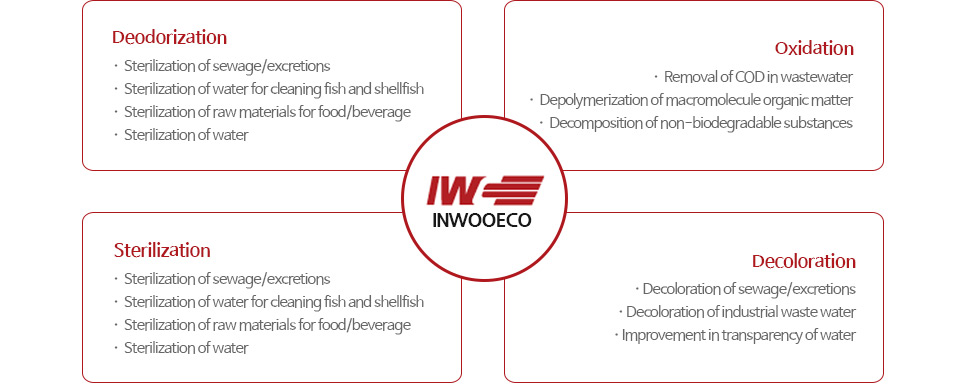CT value is germicide contact time (T) applicable to a product of residual disinfectant concentration(mg/l or ppm or g/㎥) (C).
In other words, CT value is ‘concentration of ozone × detention time’.
Some treatment requires sufficient ozone in water along with proper contact time. In advanced water treatment,
CT value of ozone is applied to a design as a standard needed for sterilization and serves as a standard for lots
of studies and experiments.
Effect of ozone
- 01 Sterilizing power
-
- Ozone kills bacteria a few thousand times quicker than chlorine.
- Virus are killed right after they touch ozone.
- Ozone kills pathogenic bacteria such as salmonella, vibrio, 0-157.
- Byproduct of ozone is oxygen only.
- Ozone is used to sterilize various bacteria
- 02 Decomposing power
-
- Decompose, oxidize and remove agricultural chemicals in fruits and vegetables
- Oxidize oil and deposit heavy metals and remove phenol.
- Remove heavy metals such as iron, aluminum, manganese and sulfur and make water soft.
- Oxidize and decompose organic and inorganic matters
- Control halogenated organic matters
- 03 Decolorization and deodorization
-
- Purify air and water
- Decolorize water and wastewater
- Remove pollutants in water
- Remove odors
- Remove taste, detergents and insecticides
Comparison of ozone generator and other sterilizing apparatuses
| Target substances | ozone | Ultraviolet rays | Chlorine sterilization |
|---|---|---|---|
| Reproduction of fish | possible | possible | impossible |
| Offensive odor treatment | possible | impossible | 약새 |
| Dissolved oxygen | Increase | Remain the same | Remain the same |
| Harmful substances | None | None | Generation of carcinogenic substance |
| Sterilization | 100% | 100% | 100% |
| Virus sterilization | 100% | 100% | Harmful if a great quantity is used |
| Secondary pollution | None | None | Harmful |
| Organic matter | Removable | Not removable | Generation of hazardous material |
| Removal of algae and sea | Removable | Not removable | Removable |
| Administrative expenses | Power cost | Power cost | power + chemicals |
| Installation charges | high | high | low |
Ozone’s sterilizing effect in a state of liquid
Ozone’s disinfection effect in a state of liquid varies depending on types and concentration of microbes present.
Ozone’s disinfection effect in a state of liquid varies greatly depending on physical and chemical conditions of water to be treated such as pH, water temperature, ammonia nitrogen, chemical oxygen demand (COD), and suspended solid in water.
Ozone can sterilize vegetative form bacteria easily because it is less influenced by pH and temperature than chlorine.
Aerobic bacteria is more sensitive to ozone than anaerobic bacteria. Spore-forming bacteria shows strong resistance to ozone.
Picture below shows ozone’s sterilizing effect on bacteria in water.

Ozone’s environmental standard
| Country | South Korea | Japan | USA |
|---|---|---|---|
| Organization | Ministry of Environment | Japan Occupational Hygiene Association | OSHA |
| Thresholds(ppm) | 0.06(8hours) | 0.06(8hours) | 0.1(8hours) |
| 0.1(1hour) | 0.12(1hour) | 0.3(15~30minutes) |
Use of ozone

Influence of ozone on human body
| Concentration | Exposure time | Influence |
|---|---|---|
| 0.05-0.1 | Immediately | Unpleasant smell |
| 0.05-0.3 | 30 min. ~6hr. | Deterioration of motor skills, Decline in learning ability |
| 0.08-0.4 | 3~4hr. | Infection of respiratory system |
| 0.1-0.3 | 1hr. | Stimulation to respiratory system, deterioration of respiratory disease |
| 01.-1.0 | 1hr. | Increased airway resistance |
| 0.1-1.0 | 2weeks | headache, visual impairments |
| 0.25-0.75 | 2hr. | Decline in lung function |
| 0.6-0.8 | 2hr | Chest pain, cough, airway stimulus |
| 0.94 | 1hr. and half | cough, hypopnes |
Determination of capacity of ozone: CT value

If CT value used in waste water treatment plant is 160, it means that dissolved oxygen rate is 160g/l min.
Operator has option to use ozone at 20ppm for 8 min. or at 40ppm for 4 min.
Fields that ozone can be applied
-
01
water treatment
Sterilization, Removal of taste and odor, Decomposition of surfactant, Removal of iron and manganese, Improvement in efficiency of coagulative precipitation, Removal of ingredient of agricultural chemical, Repression of algae, Repression of generation of carcinogenic substance(THM)
-
02
wastewater treatment
Removal of BOD, and COD, BD BOD of NBD BOD components, Decomposition and removal of cyanophenol, Depolymerization of high molecular substance
-
03
excretions and sewage treatment
Sterilization, Removal of odor, Removal of BOD and COD
-
04
Reusable wastewater
Sterilization, Removal of BOD, COD, odor and color
-
05
Use in industry
Bleaching of pulp and paper, Manufacturing of drug medicine, Strengthening of adhesive property of P.E. Experiment with aging of rubber
-
06
Cooling tower
Removal of legionella, main culprit of air-condsitioningitis, virus and bacteria, Water saving, power cost saving
-
07
Swimming pool
Alleviation of water pollution caused by excessive use of chemical, Removal of bad smell, Keeping water clear and transparent, Sterilization, Air purification, Water saving
-
08
Others
Water sterilized by ozone helps vegetable to grow and prevents food from being decomposed and keeps food fresh and keeps food from going bad
Application by classification
Ozone was used to sterilize water at first and currently it is used for sterilization of pool water , cooling water for air conditioner, control of microbes and hospital and sewage treatment.
| Water treatment field |
· Water treatment :
Ozone is used to remove smell and taste of water. Ozone is used in all phases of granular activated carbon. Ozone helps promote biologic action in active carbon and lengthen the life of active carbon. Ozone is used as part of THM’s control.
· Wastewater treatment : Ozone is used to remove color and odor, stabilize organic matters and sterilize in tertiary treatment. · Sludge treatment : Ozone is used to remove yellowish brown of secondary effluent, oxidize nitrous acid and remove COD. · Industry and drainage : Ozone is used to remove color of dye wastewater and pulp wastewater, sterilize algae in cooling water and pool water and manufacture water without bacteria. Dye whose solubility is low in water has less effect in discoloration. |
|---|---|
| Air purification field | Ozone is used to remove bad smell in exhaust gas from sludge treatment facility and food plant and deodorize refrigerator. Ozone is excellent in removing ammonia. |
| Food field |
Ozone is used to prevent processed food from going bad and keep food fresh. Ozone is used to inactivate bacteria in processing room and refrigerator. Food and cooking utensils are sterilized and cleaned in water that ozone is dissolved. Applications of ozone are as follows
① Water sterilized by ozone is used to manufacture or clean food. ② Raw materials are sterilized by ozone. ③ Ozone is used for manufacturing process and final products. ④ Air in a plant is sterilized by ozone. ⑤ Ozone gas is infused into package to keep food fresh. |
| Other fields |
Sterilization
· Sterilization by ozone results from burst and decomposition of bacteria’s cell wall. · Colon bacterium, staphylococcus, salmonella, and O157 are easily killed in even low concentration ozone. · Sterilization by ozone was used in storing food and purifying air in Europe and America early · Use of ozone has increased in USA and Japan. FDA’s GRAS. Applications Purification of water and wastewater, food storage, food processing, swimming pool, bath house, aquarium, medical instruments, hospital, clean room, beer factory, paper-making factory, bottled water factory, elevated tank, aquaculture, mothproof/insecticide, bio, water culture, livestock, cuisine, sterilizer, air cleaner, sterilization of air absorbed into air conditioner |
|
Oxidization
Removal of taste• smell, Removal of iron •manganese, Restraint of generation of carcinogenic substances, Removal of micro organic matters, Removal of agricultural chemicals, phenol and hydrogen cyanide, Removal of BOD•COD, Depolymerization of high molecular substance, Oxidization of toxic materials Applications water treatment, excretions and sewage treatment, industrial waste water treatment, semiconductor surface treatment(creation of oxidized thin film), steelworks and power plant water treatment, removal of manganese |
|
|
Deodorization
Oxidation decomposition of bad smell Applications restaurant/cuisine, food processing plant, air cleaner, refrigerator, water and wastewater treatment, rest room, hog farm/cowshed/poultry farm, refuse disposal plant, fertilizer plant, chemicals plant, printing/painting plant, dye works, etc. |
|
|
Decolorization
removal of color Fields that ozone can be applied wastewater treatment, excretions treatment, dye wastewater treatment, industrial wastewater treatment, small septic tanks, food bleaching, pulp bleaching |
|
|
Others
for treatment(Ozone therapy), Combustion improver, reaction accelerator |
Use of ozone

The amount of ozone required according to use
General ozone injection is as follows but varies greatly depending on absorption rate and water quality of target and thus separate experiments are recommended to find the amount of ozone required.
| Target | Use | Concentration of ozone |
|---|---|---|
| beverage | sterilization | 0.1~1.2 ppm |
| Decoloration | 1.5~4.0 ppm | |
| Removal of bad smell | 0.5~2.0 ppm | |
| Smell of sewage | deordorization | 0.1~ 5.0 ppm |
| Contact time is 5~30seconds in a state that ozone is mixed well | ||
| Industrial wastewater | sterilization, deordorization, removal of BOD, COD | 10~20ppm |
| Decoloration | The range of fluctuation is great | |
| Removal of phenols(colorless crystal with bad smell) | Ozone 400ppm per phenol 200ppm | |
Use of ozone generator according to its capacity
General ozone production is as follows but varies greatly depending on absorption rate, concentration and water quality of target and thus separate experiments are recommended to find ozone production.
| production(g/hr) | Size of ozone generator | Use |
|---|---|---|
| 0-10 | Small size for general use | refrigerator, water purifier, cars |
| 10-100 | Small size for industrial use | Swimming pool, extra water, fumigation |
| 100-1000 | Medium and large size for industrial use | Sewage and semiconductor |
| 1000-5000 | Large size | Night soil treatment facility |
| 5000- | Extra large size | Purification plant, pulp |
